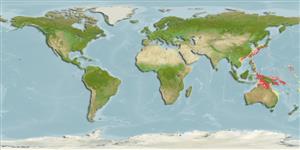Teleostei (teleosts) >
Gobiiformes (Gobies) >
Gobiidae (Gobies) > Gobiinae
Etymology: Trimma: Greek, trimma, -atos = something crushed (Ref. 45335); caudipunctatum: Named for the distinctive polka dots on the caudal fin (Latin cauda for tail and punctatum meaning spot).
Environment: milieu / climate zone / depth range / distribution range
Ecology
Marine; benthopelagic; depth range 40 - 70 m (Ref. 81089). Subtropical
Western Pacific: Japan and Palau.
Size / Weight / Age
Maturity: Lm ? range ? - ? cm
Max length : 2.1 cm SL male/unsexed; (Ref. 81089); 1.7 cm SL (female)
Short description
Identification keys | Morphology | Morphometrics
Dorsal spines (total): 7; Dorsal soft rays (total): 9; Anal spines: 1; Anal soft rays: 8 - 9; Vertebrae: 26. This specie sis distinguished by the following characters: 7 predorsal scales; 9 second dorsal-fin rays; all pectoral fin rays unbranched; first dorsal fin with no elongate and filamentous spines; fifth pelvic-fin ray unbranched; no basal membrane; no interorbital trough; 2 embedded cycloid scales dorsally on opercle; head and body light reddish yellow; fresh and color in life of snout, interorbit, and upper and lower parts of eye dark purplish blue; caudal fin vivid yellow with pale lavender polka dots (Ref. 81089).
Life cycle and mating behavior
Maturity | Reproduction | Spawning | Eggs | Fecundity | Larvae
Suzuki, T. and H. Senou, 2009. Two new species of the genus Trumma (Perciformes: Gobiidae) from Japan and Palau. Bull. Kanagawa Prefect. Mus. (Nat. Sci.) 38:107-112. (Ref. 81089)
IUCN Red List Status (Ref. 130435: Version 2024-2)
Threat to humans
Harmless
Human uses
Fisheries: of no interest
Tools
Special reports
Download XML
Internet sources
Estimates based on models
Preferred temperature (Ref.
123201): 21.6 - 28.8, mean 26.9 °C (based on 17 cells).
Phylogenetic diversity index (Ref.
82804): PD
50 = 0.5000 [Uniqueness, from 0.5 = low to 2.0 = high].
Bayesian length-weight: a=0.01023 (0.00477 - 0.02194), b=3.01 (2.83 - 3.19), in cm total length, based on LWR estimates for this (Sub)family-body shape (Ref.
93245).
Resilience (Ref.
120179): High, minimum population doubling time less than 15 months (Preliminary K or Fecundity.).
Fishing Vulnerability (Ref.
59153): Low vulnerability (10 of 100).
